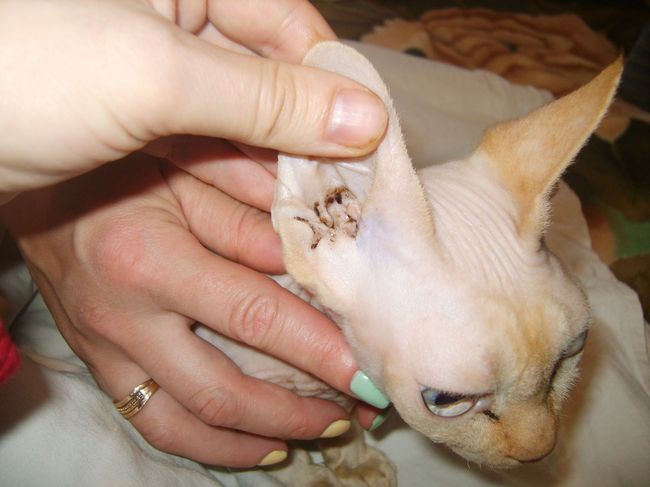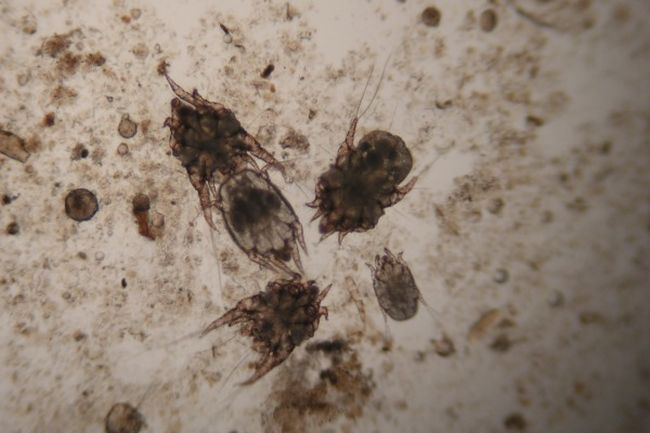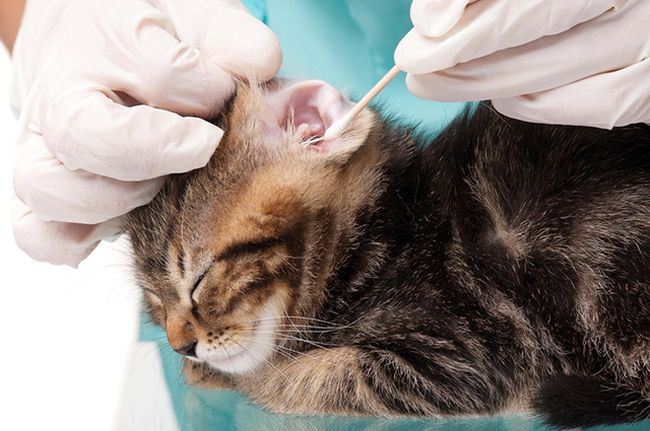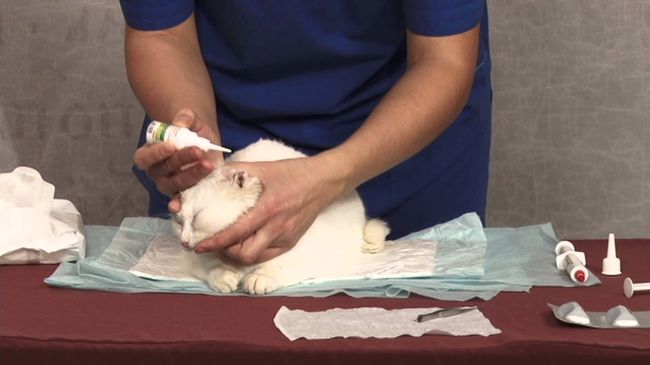otodektoz, better known, like the ear mite, It is a common disease not only of street cats and dogs, but also domestic animals, who rarely go outside. This disease can be stopped at the very beginning, if you regularly (at least once a week) inspect the pet's ears on the presence of these parasites. This should be done, if the animal is regularly communicates with other cats and cats, goes out. Do not walk on the street cat can also develop otodektoz. The fact, that ear mites in cats transmitted not only by contact, but also via insects, such as fleas and flies. Infection are more prone to kittens, but sometimes a tick occurs in adult animals.

How does the ear mites in cats? Each "kotovladelets" must be aware of the appearance of the parasite, because the enemy needs to know in the "face". Pathogen otodektoza - small mite, which does not exceed the size of 0.5 mm. The mite has an oval body and a dark color, therefore, find it in the cat's ear just enough. This parasite, living on the skin surface, so do not try to find it in the back of the ear of an animal. It is not dangerous to humans, but is able to be attached to clothing and a long time since "travel. Do not be afraid to contact with a sick cat - a person can not be infected by it. If the house several animals, the sick pet should be isolated from the rest, use a brush to coat the individual, as the tick can be transmitted to healthy cats.
symptoms otodektoza
Signs of ear mites in cats appear almost immediately after infection:
- Pet getting restless, alarming, can be aggressive, lose appetite. The cat tries his best to scratch your ear with their paws, rubs on various subjects, trying to relieve itching. Often as a result of intense scratching appear bleeding scratches, which are fraught with inflammation. It is important to avoid such a state in a feline, as the persistent attempts to scratch the ear can lead to rupture of the tympanic membrane of an animal. This will cause an inflammation of the inner ear and deafness.
- The animal tries to get rid of the tick, constantly shaking his head.
- In ear, the infected tick, It increases blood circulation, with the result that there is some swelling.
- Damaged skin is covered with brown scabs. They are formed from secretions of the parasite and metabolic products.
- Cat gradually ceases to hear the patient's ear, since the auditory meatus is closed sulfuric stopper.
- There is a particular nasty smell, which can be felt even at a distance.
- If the disease is started, the wool at the base of the ear begins to stick together due to the arising from it pus.
- The animal becomes apathetic, sluggish, possible rise in temperature. However, this is an indirect sign, which can be a symptom of a variety of other diseases.

Important: If you find your pet a few signs, do not wait for the rest, immediately contact your veterinarian, which will determine the symptoms and treatment will appoint. Especially dangerous delay, if the cat has a fever.
otodektoza treatment
Despite, that the ear mite dangerous, Treatment is simple enough, If the disease is detected in a timely manner. Launched otodektoz becomes more serious stage, so no need to engage in self-diagnosis and treat your pet without consulting with a specialist. The main task of the vet - diagnosed correctly and treated, host task - to detect symptoms and seek medical advice.
The choice of drugs is largely curled condition of the animal from disease and neglect. Drugs may be produced in the form of powders, drops, ointments, injection, aerosols. If the animal is ill recently, the vet most commonly prescribed drugs such as "Amitraz", Akromektin, 'Tactic', «Amitrazin». If a pet is because of infected ticks has become too nervous and irritable, It does not allow to touch the ears, it is necessary to use special sprays. To the drug has reached the target enough to spray it at a distance of five centimeters from the cat's ear. Most such aerosols are produced based on such drugs as "Akrodeks", "Ciodrin", "Dermatozol". It is also important to state of the animal and its age. So, kittens up to six months and pregnant cats, many drugs are contraindicated because of the high toxicity. Safe for cats dosage should be calculated vet.

Remedy for ear mites in cats can be administered intramuscularly. Injections are appointed already, when the disease is caused by inflammation, and removing the tick one animal does not help. In this case, use a spray or ointment to kill the parasite, and intramuscularly injected "Otodektin".
Home Treatment
treatment otodektoza - a lengthy process, it takes an average of 7 to 10 days, During this time, adult ticks are killed. Medications used for 3 weeks, to destroy the eggs of parasites. After that, vet diagnose and prescribe drugs, continued treatment at home.
The owner must be applied drugs daily for damaged areas, after cleaning the ear cat. Getting rid of formed crusts, purulent discharge, mite feces using cotton swabs. They should in wet hydrogen peroxide (solution 2%). The solution is gently macerates crust and scabs, after which they are easily removed. It is important to be alert to the, that your pet is unlikely to be glad of such a procedure, touching the ears do not like even a healthy cat.

When the cat ears will be cleaned thoroughly, must be applied to drug. This is done also with the help of a cotton bud, wherein the means gently rubbed into the skin.
Remove ticks can not be mechanically, so as not to injure the skin of the ear more. Under the action of drugs parasites gradually die and are removed at cleaning cotton cane ear. For successful treatment just once a day to carry out procedures. With timely treatment of early ears are clean about the fifth day, but should be kept at least a week. To avoid relapse, All cats must be treated skin antiparasitic agents.
After the end of the treatment course must pass repeated tests, that show, remained mites or not.
If the cat is very nervous and worried, veterinarian appoints auxiliary products. Usually it is "Otonazol", Vishnevsky ointment, drugs, containing sulfur. These funds do not kill mites, but to help reduce inflammation and have a calming effect.
In advanced cases of tick-borne infections veterinarian may prescribe an intramuscular injection of antibiotics.
mites folk remedies Treatment
By folk remedies may be resorted to only in the event, if the disease is at an early stage, or you can not contact your veterinarian. It is important not to forget, that the health and life of a pet is completely dependent on the host.

To get rid of mites commonly used oil. They are applied to the affected skin, blocking the parasite access to oxygen. This forces him to leave the "old haunt" the place and flee. It is best to use almond place - it is devoid of noxious fumes and produces a calming effect. Pre-need to make sure, that the cat is not allergic to the tool. To do this, apply a drop of oil to clean skin of the animal. If within half an hour there was no redness or swelling, tool can be used. Apply the oil on the need to pre-cleansed ears.
During the period of treatment should be regularly wet cleaning, possible to remove the floor carpet. Mite can live for more than two months without a host, because there is a risk of re-infection.
The recovery period cat shows fresh air and balanced diet with reduced protein. This will help the animal to not be nervous and calmly endure discomfort.












